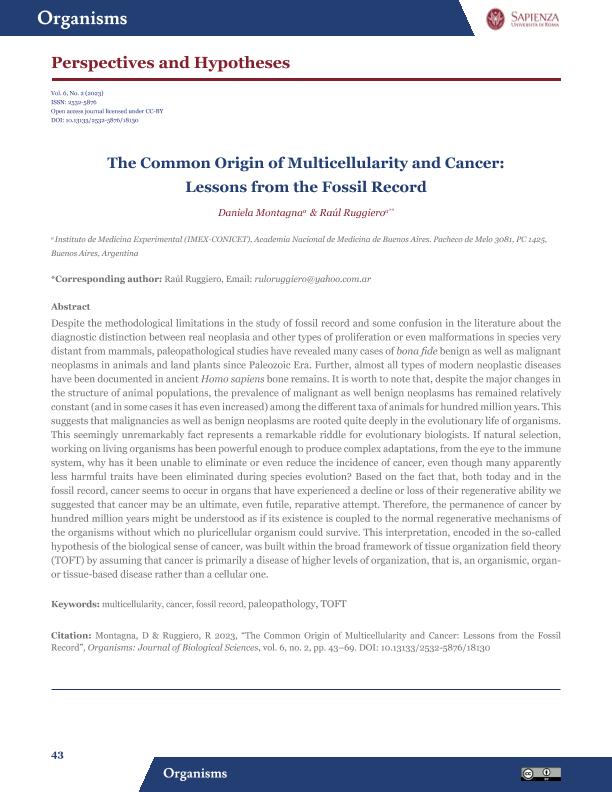Artículo
The common origin of multicellularity and cancer: Lessons from the fossil record
Fecha de publicación:
11/2023
Editorial:
Sapienza University of Rome. Department of Experimental Medicine
Revista:
Organisms
ISSN:
2532-5876
Idioma:
Inglés
Tipo de recurso:
Artículo publicado
Clasificación temática:
Resumen
Despite the methodological limitations in the study of fossil record and some confusion in the literature about the diagnostic distinction between real neoplasia and other types of proliferation or even malformations in species very distant from mammals, paleopathological studies have revealed many cases of bona fide benign as well as malignant neoplasms in animals and land plants since Paleozoic Era. Further, almost all types of modern neoplastic diseases have been documented in ancient Homo sapiens bone remains. It is worth to note that, despite the major changes in the structure of animal populations, the prevalence of malignant as well benign neoplasms has remained relatively constant (and in some cases it has even increased) among the different taxa of animals for hundred million years. This suggests that malignancies as well as benign neoplasms are rooted quite deeply in the evolutionary life of organisms. This seemingly unremarkably fact represents a remarkable riddle for evolutionary biologists. If natural selection, working on living organisms has been powerful enough to produce complex adaptations, from the eye to the immune system, why has it been unable to eliminate or even reduce the incidence of cancer, even though many apparently less harmful traits have been eliminated during species evolution? Based on the fact that, both today and in the fossil record, cancer seems to occur in organs that have experienced a decline or loss of their regenerative ability we suggested that cancer may be an ultimate, even futile, reparative attempt. Therefore, the permanence of cancer by hundred million years might be understood as if its existence is coupled to the normal regenerative mechanisms of the organisms without which no pluricellular organism could survive. This interpretation, encoded in the so-called hypothesis of the biological sense of cancer, was built within the broad framework of tissue organization field theory (TOFT) by assuming that cancer is primarily a disease of higher levels of organization, that is, an organismic, organor tissue-based disease rather than a cellular one.
Palabras clave:
Multicellularity
,
Cancer
,
Fossil record
,
Theories of cancer origin
Archivos asociados
Licencia
Identificadores
Colecciones
Articulos(IMEX)
Articulos de INST.DE MEDICINA EXPERIMENTAL
Articulos de INST.DE MEDICINA EXPERIMENTAL
Citación
Montagna, Daniela Romina; Ruggiero, Raul Alejandro; The common origin of multicellularity and cancer: Lessons from the fossil record; Sapienza University of Rome. Department of Experimental Medicine; Organisms; 6; 2; 11-2023; 43-69
Compartir
Altmétricas




